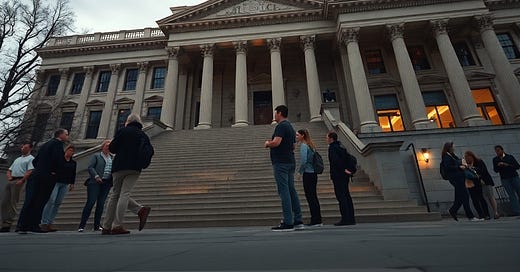The Power of State and Local Governments in Shaping Policy
Part of the series: "Defending Democracy: Strategies to Counter President Trump's Policies within the American System"
“All politics is local.” – Tip O’Neill
Introduction: Understanding Federalism in the Current Political Climate
With Republicans controlling the presidency, the Senate, the House, and a conservative-leaning Supreme Court, many progressive policies face significant federal roadblocks. However, history shows that state and local governments serve as essential counterweights to federal overreach.¹
The legal framework of federalism ensures that states maintain power to act independently, even in opposition to federal mandates. While states have constitutional protections under the Tenth Amendment, local governments function within limits set by state legislatures.² This essay examines how state and local governments can drive policy change, challenge federal authority, and operate as laboratories of democracy.
1. Constitutional Foundations of Federalism
The U.S. Constitution establishes a dynamic but contested balance between state and federal power. The Tenth Amendment reserves unallocated powers to the states, yet the Supremacy Clause (Article VI) ensures that federal law takes precedence when conflicts arise.³
Key Supreme Court Rulings on Federal-State Relations
New York v. United States (1992): The federal government cannot compel states to enforce federal regulations, reinforcing state autonomy.⁴
Printz v. United States (1997): Confirmed that states cannot be forced to implement federal mandates, strengthening the concept of independent governance.⁵
McCulloch v. Maryland (1819): Established federal supremacy, limiting state interference in national affairs.⁶
While the courts have strengthened states’ rights in some cases, they have also reaffirmed federal dominance in areas such as civil rights and commerce.⁷ Understanding these rulings helps states navigate legal challenges against federal policies.
2. State Governments as Policy Laboratories
Supreme Court Justice Louis Brandeis famously described states as “laboratories of democracy”, where policy experimentation can lead to national reforms.⁸ Progressive policies often emerge at the state level before influencing federal legislation.
Key Areas of State-Led Policy Innovation
Healthcare: States expanded Medicaid even when federal support was uncertain.
Climate Policy: California’s emission standards set benchmarks for national environmental policy.
Minimum Wage: Many states raised wages beyond the federal minimum, reshaping labor laws.
Gun Control: States like New York and Connecticut enacted stricter firearm regulations despite federal inaction.
These examples highlight how state governance influences national policymaking, forcing industries and policymakers to adapt.⁹
3. The Role and Limits of Local Governments
Unlike states, local governments are not sovereign entities. They operate under powers granted by state legislatures. This means that while cities can enact progressive policies, their authority is often subject to state intervention.¹⁰
Local Governments as Frontline Defenders
Sanctuary Cities: Major cities like Los Angeles and Chicago have limited cooperation with federal immigration enforcement.
Public Health Initiatives: During COVID-19, cities implemented restrictions that sometimes contradicted state and federal policies.
Policing Reform: Some city councils have taken independent action to revise law enforcement practices.
However, states can override city policies, particularly in conservative-controlled states where legislatures seek to limit progressive city governance.¹¹
4. Legal Challenges: State Attorneys General vs. Federal Authority
One of the most effective tools states have in resisting federal overreach is litigation. State attorneys general (AGs) frequently sue the federal government to block executive actions or policy rollbacks.¹²
Notable Legal Battles
Environmental Protection: States sued the Trump administration over weakened environmental regulations, leading to reinstated protections.
Voting Rights: AGs challenged federal efforts to restrict voting access through lawsuits and state-level protections.
Healthcare: States defended the Affordable Care Act (ACA) in court to prevent its dismantling.
State litigation is a powerful tool for slowing or blocking federal policies, particularly when legal precedents favor state autonomy.¹³
5. Economic Power: State Budgets and Financial Leverage
States control substantial economic resources, allowing them to counteract federal budgetary policies through independent financial decisions.¹⁴
Strategic Budgeting for Policy Independence
Redirecting Federal Cuts: States can use their own budgets to maintain funding for healthcare, education, and infrastructure.
Tax Policy: States can create tax structures that support progressive economic policies.
Public-Private Partnerships: Collaborations with private companies can fund green energy initiatives or transportation improvements.
Economic power allows states to sustain progressive policies even under conservative federal administrations.
6. Leveraging Public Opinion and Ballot Initiatives
When legislative avenues are blocked, direct democracy tools such as ballot initiatives and referendums offer a way for citizens to drive policy change at the state level.¹⁵
Successful Ballot Initiative Examples
Medicaid Expansion: Voters in red states like Nebraska and Idaho expanded Medicaid through ballot measures.
Minimum Wage Increases: Florida voters approved a $15 minimum wage despite opposition from state lawmakers.
Marijuana Legalization: Ballot initiatives led to cannabis legalization even in conservative states.
Ballot measures empower citizens to bypass partisan gridlock and enact progressive policies directly.
Conclusion: Strategic Resistance and Long-Term Political Influence
While Republicans currently control the federal government, state and local governments remain vital battlegrounds for progressive policymaking. Their ability to enact independent policies, challenge federal mandates through litigation, and leverage economic power ensures that opposition movements continue to shape national policy.
Through legal action, budgetary control, grassroots activism, and electoral strategies, state and local governments will continue to serve as counterweights to federal overreach.¹⁶ Long-term electoral investments in state legislatures, attorneys general races, and ballot initiatives will be crucial for sustaining progressive gains.
By recognizing the strategic role of state and local governance, progressives can push back against federal policies, implement meaningful change, and lay the foundation for future national victories.
References
Stephen Tierney, The Federal Contract (Cambridge: Cambridge University Press, 2020), 32.
Ibid., 47.
Federalism Analysis, ed. John Smith (New York: Oxford University Press, 2021), 22.
New York v. United States, 505 U.S. 144 (1992).
Printz v. United States, 521 U.S. 898 (1997).
McCulloch v. Maryland, 17 U.S. 316 (1819).
Tierney, The Federal Contract, 88.
Federalism Analysis, 12.
Tierney, The Federal Contract, 102.
Ibid., 115.
Federalism Analysis, 33.
Ibid., 47.
Tierney, The Federal Contract, 150.
Federalism Analysis, 78.
Ibid., 91.
Tierney, The Federal Contract, 189.




